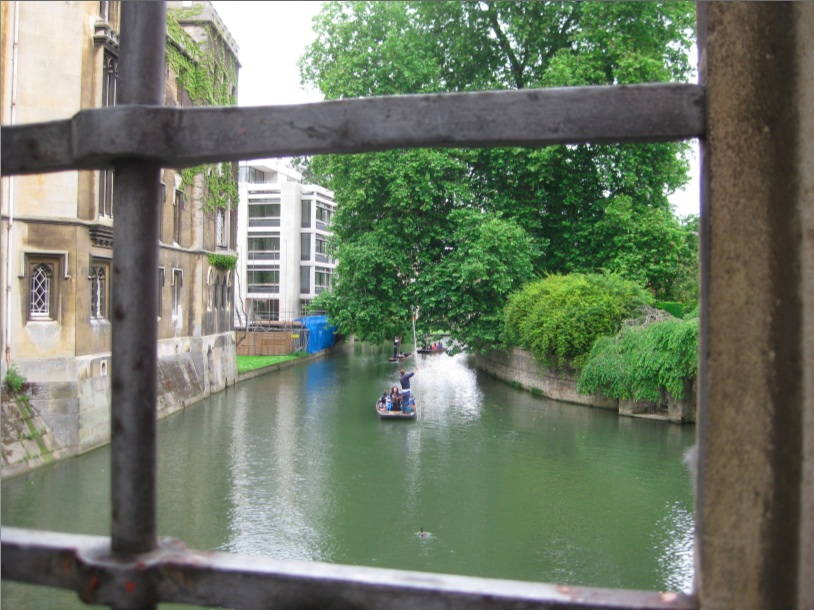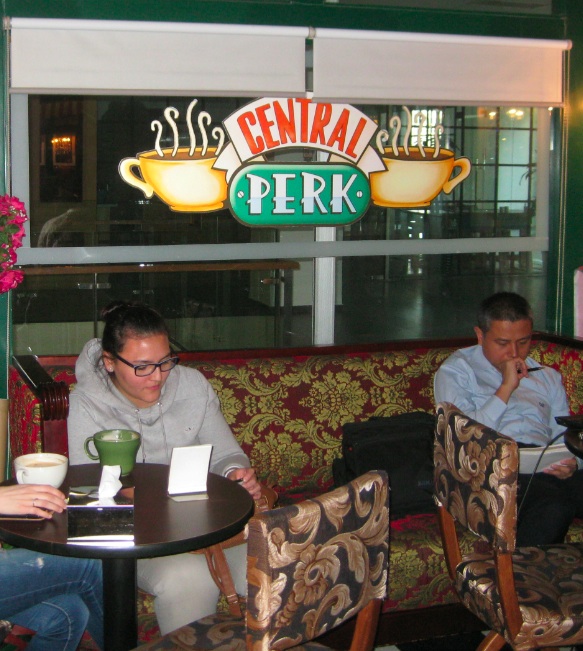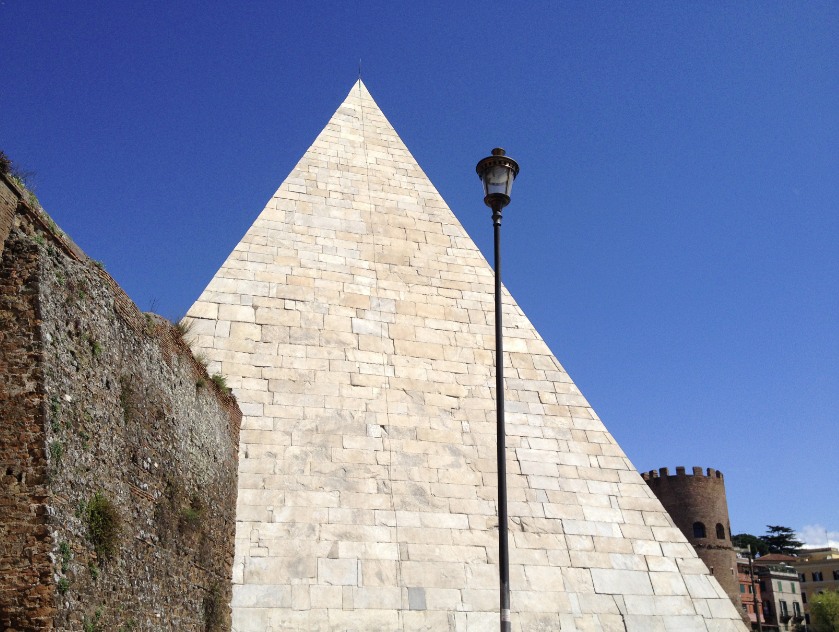While traveling last summer, I asked for directions to get to the room in which I would be staying for the night, and was told to “cross the Bridge of Sighs” and make a right. I wasn’t in Venice, in spite of how it might sound, or in China —a country now famous for faux architecture sites, one of which, Thames Town, features a church and a fish and chips shop that look just like doppelganger locales in England. I wasn’t in Las Vegas, the American city most closely associated with shanzhai (copycat or counterfeit) versions of European iconic structures, thanks in part to a miniature Eiffel Tower. I wasn’t attending a World’s Fair-like international exhibition or visiting a theme park, such as Epcot Center — two settings often rife with replicas.
Where was I? Cambridge, England. The man directing me to cross the Bridge of Sighs worked in the porter’s lodge of St. John’s, the college where the organizers of the local World History Seminar had arranged for me to stay while in town to present.
I had come to Cambridge from Oxford, where I spent part of last summer as a Visiting Research Fellow at Merton College. I mention this because, had I come to Cambridge directly from the United States, being told to cross a bridge with the same name as one famous in Italy would have seemed very strange indeed. As it was, it seemed only a bit strange, for earlier in that same week, when asking directions in Oxford, I had also been told to use the Bridge of Sighs as an orienting landmark. Yes, that university town also has a shanzhai version of the same Italian icon — though curiously, one that spans a road, not a waterway.
During my month in England, I didn’t mention my interest in faux Italian bridges to anyone, but my guess is that if I had, those to whom I told the story might well have found it curious that I found it curious. After all, some old English estates contain follies meant to call to mind ancient Roman ruins. But given my interest in China and having read many articles over the years about the craze for shanzhai buildings in that country, which boasts replicas of structures ranging from the White House to Sydney’s famed Opera House, the case of the bridges seemed worth noting and pondering.
In thinking about the situation, I was reminded again of how easy it is to overstate the exoticness of contemporary China, and of the need to differentiate carefully between things going on there that are utterly sui generis, on the one hand, and those that represent a recurrence, sometimes with very distinctive features, of things that have happened or are happening elsewhere. Is Thames Town peculiar? Yes. And so, too, is the faux Great Wall that Wuhan University is building. But can such fakes also be fit into a long tradition of look-alike structures scattered in locales far beyond China, such as the massive Parthenon dating from 1897 that was built in Nashville, Tennessee, for a World’s Fair-like international exhibit? Again, yes.
*
Well before I went to England, I already had shanzhai buildings on my mind due to a trip to China I had made the previous March. I still haven’t managed to make it to Thames Town (maybe next time), but I had stopped in at unusually interesting replica sites in three different cities. While in Shanghai, I’d gone to the 221B Baker Street Café. This, as its name suggests, is a shanzhai version of a place that never actually existed except on paper, in the theater, in film, and most recently on television. That globally famous address, of course, is one that Sir Arthur Conan Doyle invented to go with the place of residence for his fictional detective Sherlock Holmes. This particular example of Shanghai shanzhai was not based on the flat described in Conan Doyle’s books. Rather, it was inspired by the one featured in the BBC contemporary-set series starring Benedict Cumberbatch and Martin Freeman — something that showed through in many ways, including the presence of some memorabilia associated with the recent films based on The Hobbit, in which the two actors also have roles.
The second shanzhai site I saw in March 2014, which also had a “Britain transplanted to China feel,” was in nearby Ningbo. I went there with fellow China Blog editor Maura Cunningham to give a tag-team talk on the 2013 edition of China in the 21st Century: What Everyone Needs to Know, on which we had collaborated, at the local branch of the University of Nottingham. One of the main sites we saw on the brief campus tour that preceded our talk was a building with a clock tower that is a replica of the one on the original British campus.
Last but far from least, while in Beijing, I went to a mock-up of the Central Perk coffee shop made famous by Friends, the American sitcom that, as regular readers of this blog know, has many fans in China. Located in a shopping center in China’s capital, it replicates several features of the show’s set — though, unlike the Central Perk seen by viewers of the show, this one’s orange couch sits in front of a television set. When I visited it, some young Chinese sat at tables chatting or working on their laptops, while others lounged on that couch watching the eponymous friends — Chandler, Monica, Ross, Rachel, Phoebe, and Joey — making jokes and getting in and out of scrapes.
These sites, when taken together, reveal the extent to which China and the West have become intertwined. It is worth noting, though, that a full account of shanzhai architecture requires moving not just outside of China but also back in time. Many decades before Shanghai got a café inspired by a BBC show, it had a Big Ben-like clock tower. And several centuries before Beijing got its Central Perk, it had the Yuanming Yuan complex, also known as the Old Summer Palace, which was, as works by Geremie Barmé and others show, a wondrous copycat-rich theme park avant la lettre. Spending time there, the Emperor, without leaving his capital, could take virtual tours of the world, viewing mockups of everything from Hangzhou gardens to Tibetan temples to, in the middle of one lake, a miniature version of Venice. There’s just one question about that last site I wish I could answer: Did it include a replica of the Bridge of Sighs?
*
How far back in history can we take the tale of shanzhai architecture? I’m not sure, but a recent trip to Rome convinced me that no discussion of the topic will be complete without bringing in things built long before the first Jesuits went to China. Scattered throughout the Italian capital’s ancient core are buildings roughly two thousand years old that were inspired by — and sometimes intended to reproduce exactly — Greek ones that predated them by several centuries. One particularly interesting structure located a bit outside of the core district, meanwhile, is a faux version of an Egyptian structure: a pyramid. It was built by a local man who wanted to be buried in the grandeur of pharaohs of old; one can imagine his plan inspiring some of the same eyebrow-lifting and disparaging comments about crude emulation of another place’s elite that has been generated lately by the nouveau riche Chinese man who has built a replica of the White House in which to live.
Perhaps the most interesting Roman shanzhai sites of all for me, given my interests, were the obelisks scattered around the city. Some of these are not fakes, but simply objects brought to Rome from Egypt. Others, however, were built outside of Egypt in an Egyptian style, something that could also be said of the Washington Monument, the most famous American obelisk. Still others are part genuine transplant and part fake, a reminder that the line between authentic and shanzhai creation can sometimes be fuzzy.
For example, at the top of the Spanish Steps stands a menhir — known officially as the Sallustiano Obelisk but also called the Trinità de Monti Obelisk, in honor of the name of a nearby church — that was apparently brought to Rome from Egypt, but has a hieroglyphic inscription that is a later addition, carved by Roman rather than Egyptian craftsmen. In chiseling it in, they used as a model the inscription on another obelisk that had made the journey from Egypt to Rome. They were not, however, as meticulous as they might have been, for errors snuck in, as sometimes happens in any form of shanzhai work. In this case, some images were carved upside down, meaning that they looked like hieroglyphics but, like the fascinating faux Chinese characters created by the artist Xu Bing, were actually nonsensical symbols. I will think about that inscription the next time I see a T-shirt for sale in Shanghai that is emblazoned with a slogan in Chinglish that verges on gibberish, or see a Westerner anywhere sporting a tattoo made up of Chinese characters that are drawn incorrectly or grouped together oddly.
*
The shanzhai story is a complex, long, and global one, and new chapters are being added to it continually. This is especially true in years, like this one, when World Expos are held. The 2015 Expo will take place in Milan and be the first since Shanghai’s in 2010, which broke records for numbers of pavilions and visitors.
When the World Expo came to Shanghai, it gave a city already rich in permanent doppelganger objects a host of temporary new ones. The Indian pavilion, for example, was topped by a dome modeled on the one at a World Heritage site dating from the 3rd century B.C.; those taking a virtual tour of Switzerland were able to ride on a mock Alpine chair lift. As a visitor, I saw replicas of ancient Southeast Asian temples in Cambodia’s exhibit area. These were modeled on the Angkor Watt temple complex, but as someone who has never been there, they gave me a sense of déjà vu, not for any past trip to Southeast Asia but rather a past stop at Disneyland where a shanzhai version of the same site exists. (I wish I could say that the Venice city pavilion at which I stopped had a Bridge of Sighs, but it didn’t, though it did boast shanzhai canals.)
What curious new chapters to the shanzhai story will this year’s far more modest World Expo, which opened May 1, add? I am planning to visit Milan in September to find out. And although I saw little while in Rome in April to suggest that locals were excited about a World Expo starting soon in another part of their country, there were some posters scattered around the city drawing attention to the event. Fittingly, one of the largest billboards I saw promoting a spectacle that will surely have its share of copycat dimensions was directly behind that obelisk atop the Spanish Steps that is adorned with upside down hieroglyphics.








